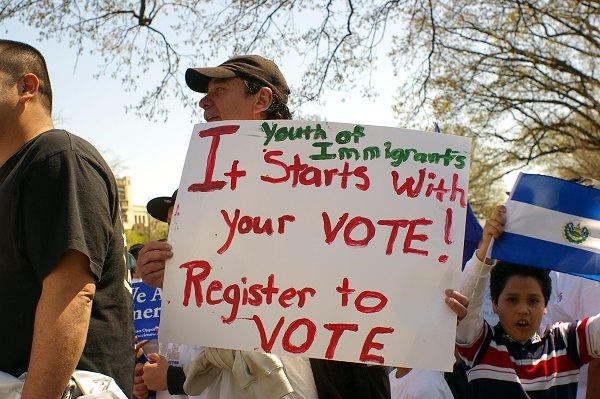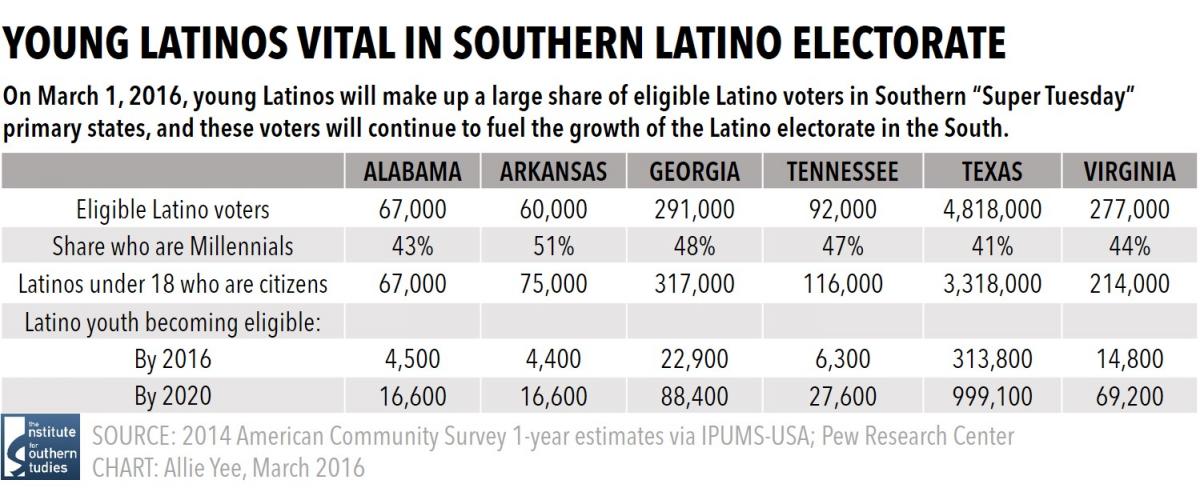Young Latino voters a growing force in Southern 'Super Tuesday' states

As Latino youth who are citizens turn 18 and become eligible to vote, they will be a driving force behind the growth of eligible Latino voters in Southern "Super Tuesday" primary states. (Photo by Luigi de Guzman via Flickr.)
As Southerners go to the polls this week to cast their ballots for this year's presidential nominees, an important voter demographic is emerging in these "Super Tuesday" primary states: young Latino voters.
Across the South, Latino communities have grown dramatically in recent decades, but their electoral influence has not expanded nearly as quickly due to the fact that the population is disproportionately young, and that many of those who are of voting age are not citizens.
But current trends suggest that the recent influx of young Latino eligible voters into the electorate has the potential to significantly expand the role of Latinos in Southern politics. Already Millennials between the ages of 18 and 33 make up 40 to 50 percent of eligible Latino voters in Southern states, and their influence is only expected to grow.
A recent Institute for Southern Studies report found that half a million Latino youth in the South* will have turned 18 between 2014 and 2016 and become eligible voters in this year's presidential election. Between 2014 and 2020, an estimated 1.6 million Latino youth are expected to age into the electorate.
These trends have important implications for this year's presidential election and future elections in "Super Tuesday" states in the South, which include Alabama, Arkansas, Georgia, Tennessee, Texas and Virginia. Although the size of the Latino population and electorate varies by state, young Latinos make up a disproportionate share of eligible Latino voters in each, and young Latinos will be a key driver of continued growth of Latino voters in 2016 and beyond.
 Here's how those trends play out in a few key "Super Tuesday" states:
Here's how those trends play out in a few key "Super Tuesday" states:
Texas
With a long history of immigration and more established Latino communities, Texas leads not only the South but most of the country in terms of the size of its Latino electorate.
The state has 4.8 million eligible Latino voters — second only to California, according to the Pew Research Center's analysis of 2014 Census data. Latino voters make up 28 percent of all eligible voters in the state.
The Latino electorate in Texas, already large, is expected to continue to grow with young Latinos a key factor in further expanding the voting-eligible population. In 2014, Millennials made up 41 percent of eligible Latino voters in Texas, compared to 31 percent of all eligible voters.
The state also has a large under-18 Latino population, 95 percent of whom are U.S. citizens, that will continue to add to these numbers. Between 2014 and 2016, over 300,000 young Latino citizens will have joined the electorate in Texas. Between 2014 and 2020, nearly a million will join.
See year-by-year estimates of the number of Latino youth becoming eligible voters in Texas here.
Georgia
Georgia also has a substantial Latino population, but unlike Texas it faces a much bigger gap between the overall Latino population and those who are eligible to vote. The number of Latino residents in Georgia is approaching a million, making up 9 percent of the state's overall population.
But Latinos have a smaller presence among eligible voters in the state. Due to age and citizenship rates, only about one in three Latino residents are eligible to vote. (See age and citizenship breakdowns of Georgia's Latino population here.) The state's 291,000 eligible Latino voters make up 4 percent of all eligible voters in the state. They make up 2 percent of registered voters.
The role of young Latino voters in this context is critical. Already 48 percent of eligible Latino voters in Georgia are Millennials. In 2014, there were 317,000 Latinos who were under 18 and U.S. citizens — more than double the size of the state's current Latino electorate. These youth will turn 18 and age into the electorate at the rate of about 18,000 new eligible voters each year.
In Georgia, and in states like North Carolina and Virginia that are experiencing similar demographic trends, the Latino vote could be pivotal in these states' razon-thin margins in state, federal and presidential races. Exercising that electoral influence will hinge on mobilizing young Latinos in this year's election and for years to come.
Arkansas
A similar dynamic in the Latino electorate is playing out in Arkansas. Although the scale is smaller in Arkansas, which has only 205,000 Latino residents, the impact of young voters could be even more profound.
Arkansas' Latino immigration population is very new, and, as a result, the state has an especially large voter eligibility gap among Latinos. Latinos make up 7 percent of all residents but only 4 percent of eligible voters. Only 29 percent of Latinos in the state are eligible to vote — ranking the state 49th in the country in terms of eligible voter share.
But the growth of young Latinos in Arkansas could substantially shift that trend. Over half — 51 percent — of eligible Latino voters in Arkansas are Millennials, and many more young people are expected to join them. While there are 60,000 eligible Latino voters in the state right now, there are 75,000 Latinos under 18 who are citizens who will become eligible voters in less than two decades.
See how many young Latinos are estimated to become eligible voters in Arkansas here.
* Southern states included in this total are Alabama, Arkansas, Florida, Georgia, Kentucky, Louisiana, Mississippi, North Carolina, South Carolina, Tennessee, Texas and Virginia.
Tags
Allie Yee
Allie is a research fellow at the Institute for Southern Studies and is currently studying at the Yale School of Management. Her research focuses on demographic change, immigration, voting and civic engagement.
